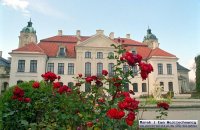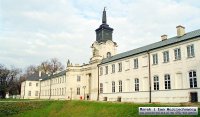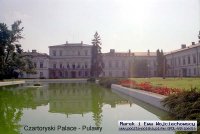 There are several magnificent princely palaces in the Lublin region.
Of these, the Zamoyski palace, Kozłówka, is the finest because, unlike so many Polish treasures, it has survived the wars undamaged, even the furniture and the collection of 1000 paintings are the original treasures of the Zamoyski family. The palace, remodeled by Konstanty Zamoyski in the French Empire style, stands in a 20 ha (47 acre) well-kept park.
There are several magnificent princely palaces in the Lublin region.
Of these, the Zamoyski palace, Kozłówka, is the finest because, unlike so many Polish treasures, it has survived the wars undamaged, even the furniture and the collection of 1000 paintings are the original treasures of the Zamoyski family. The palace, remodeled by Konstanty Zamoyski in the French Empire style, stands in a 20 ha (47 acre) well-kept park.
The large 18th.C Potocki palace at Radzyn Podlaski was burned by the Germans in 1944. Although totally rebuilt, it is only interesting from the outside because the interior now houses offices.  .
.
The palace and park of the Czartotyski family in Puławy is one of largest such installations in Poland. The palace was transformed from the original Baroque to the Classic style at the beginning of the 19thC. The main art collections were moved to the Czartoryski Palace (now museum) in Cracow about 1830. In 1862 the Agricultural and Forestry Institute was established in the palace. Today it is the Institute of Soil Science and Plant Cultivation, part of the National Research Institute. The ceremonial rooms of the palace may be visited, as well as the two small museums established by countess Isabela Czartoryski in the 1830s - The Sybil Temple and the Gothic House - located within the extensive park.
 Kazimierz Dolny, just half an hour by bus from Puławy, is an exquisite Renaissance small town, dominated by the ruins of medieval castle. It is described on a previous page South Poland Tour.
Kazimierz Dolny, just half an hour by bus from Puławy, is an exquisite Renaissance small town, dominated by the ruins of medieval castle. It is described on a previous page South Poland Tour.
Zamość, "pearl of Polish baroque" recognized as a World Heritage site by UNESCO, is also described on the same page, see also the
photos.
How to get there. Puławy and Lublin are reached easily by the same trains from Warsaw - 2 1/2 hours to Lublin, under two hours to Pulawy. Some of the same trains continue to Zamość, taking another 2 1/3 hours. Kazimierz Dolny is reached by express bus from Warsaw, or local bus from Puławy. The other palaces are best reached by tour bus.
The most notorious, but largely forgotten Nazi extermination camps were located in this area of Poland, along the river Bug see map .
Bełżec, Sobibor and Treblinka differed from other concentration camps, such as Auschwitz/Oświęcim or Matthausen, in that they were set up for the sole purpose of exterminating Jews, not as camps housing forced labor in industry or mines. Except for a small number of the strongest and most healthy, the arriving prisoners were marched directly from the train to huts where they were forced to undress and remove all jewelery, then marched straight on to the gas chambers, disguised as "showers". The Nazis were in such a hurry that no attempt was made to keep records. Those that were spared were used for the camp's operation, primarily for removing the bodies from the "showers" and burning them. Eventually they themselves were killed. The only survivors of these camps were a few that managed to escape after rebellions in the camps at the end of 1943. The Nazis then destroyed all evidence of the camps' existence, and covered them with earth. Today small memorials have been erected at each site.
 It is estimated that in Treblinka close to 750,000 were murdered between July 1942 and October 1943, in Belzec about 600,000 between March 1942 and spring 1943, Sobibor about 250,000 between May 1942 and October 1943.
It is estimated that in Treblinka close to 750,000 were murdered between July 1942 and October 1943, in Belzec about 600,000 between March 1942 and spring 1943, Sobibor about 250,000 between May 1942 and October 1943.
Majdanek, on the outskirts of Lublin started as a prisoner-of-war camp for Russian prisoners in October 1941. Then it was transformed into a concentration camp housing Polish political prisoners, Jews and Gypsies, to provide labor for German industries and other operations in the vicinity. Initial deaths occured from starvation, sickness and executions. In late 1942 a section of the camp was turned into an extermination site with gas chambers. The camp was over-run by the Soviet army in late July 1944 before it could be destroyed. It is estimated that about 200,000 died at Majdanek over a 3-year period, about half of them Jews. Today the entire camp serves as a memorial, it is now within Lublin city limits.
This space is available for sponsored links and ads,
See details.
|
